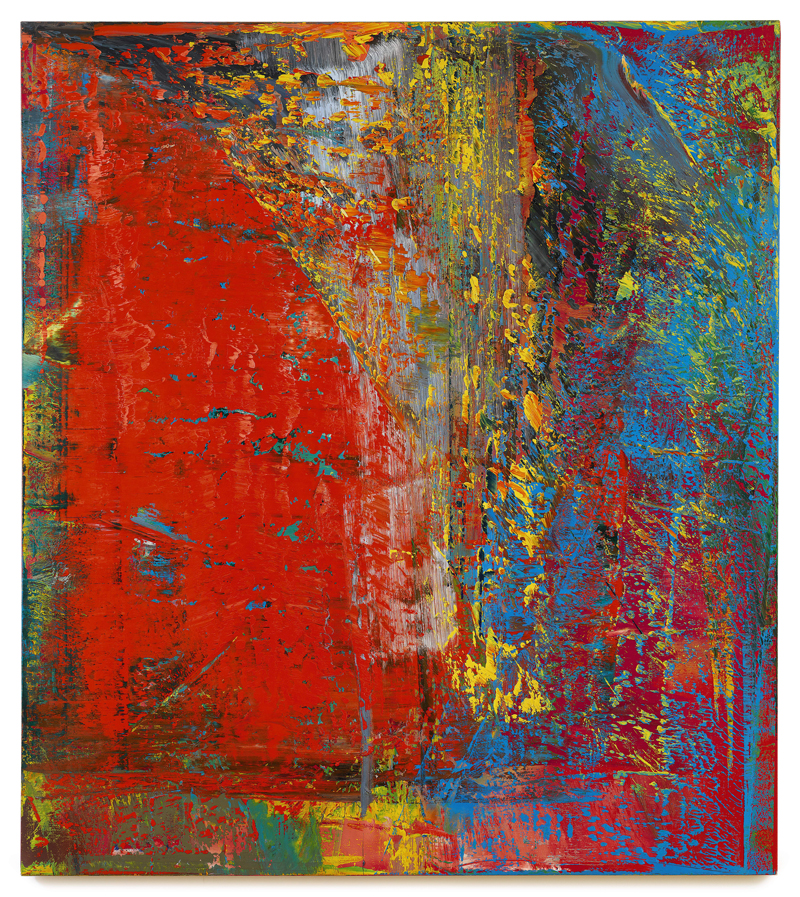Sotheby’s wrapped up this week’s string of evening sales in New York with a $276.6 million contemporary art evening sale, pulling in a total that well exceeded its low estimate of $209 million. The sell-through of 94 percent by lot was the week’s most impressive, with only 4 of 64 lots failing to sell, a strong performance for such a large sale.
The outcome was greatly bolstered by the first appearance of works from the Steven and Ann Ames collection, which Sotheby’s guaranteed for $100 million earlier this year. The sale opened with a suite of paintings and works on paper from the collection, and the 25-lot opening salvo totaled $122.7 million.
“I thought tonight’s energy was extraordinary,” said Oliver Barker, the European co-chair and the auctioneer for the evening, in a post-sale press conference. “We’ve clearly put to bed any rumors about the market.”
And yet, like the contemporary sale at Christie’s on Tuesday—which raked in an eerily similar total to tonight’s Sotheby’s sale, $277.5 million—the result was down compared to the same auction last year. It was not down by much at Sotheby’s, just 6 percent, but the dip that Christie’s saw this year was 16 percent. Any amount of downward trend is discouraging for collectors, and can cause collectors to hold tightly to works they think will sell for more when this market contraction ends. (Thursday night did mark an improvement over the May contemporary sale at Sotheby’s, which pulled in $242.2 million, though that sale had only 42 lots.)
“In terms of the amounts of lots, supply has been an issue this year,” Barker told me when I followed up about how the market trouble can be “put to bed” if sale totals are going south year by year. “Some of our clients were concerned about the economy in China, so there has been a bit of a drought.”
“But the sell-through rate is fantastic, and I’m very bullish,” he went on. “I have a very positive outlook.”
Indeed, the feeling in the salesroom was positive, and the chest-beating of the Ames collection provided early propulsion that endured through the sale. By the end, even if the sea of chairs was two-thirds empty, specialists were still jousting over lots and pushing them well over their high estimates. The low number of passes on lots also let the sale radiate success and continue to hum along, as no portion was marred by the room-deadening groans that accompany a run of failed efforts. (One lot that did fail to sell, Anselm Kiefer’s Dein Aschenes Haar, Sulamith, 1981, was curiously reinserted into the sale after the official final lot and eventually sold for $2.11 million, barely over its low estimate.)
The sale notched artist records for David Hockney and Njideka Akunyili Crosby—the Nigerian-born artist whose Drown (2012) attracted 10 bidders and sold for nearly four times its high estimate, at $1.09 million—while there were records for work on paper for Mark Grotjahn and Mike Kelley.
The highlight of the sale was Gerhard Richter’s A B Still (1986), which sold for $34 million to the bidder on the phone with Gallus Pesendorfer, a specialist in Sotheby’s Munich, indicating that the painting was going back to the artist’s home country after spending the last few decades in the U.S. It was originally sold at Marian Goodman on West 57th Street, before being put up for auction at Sotheby’s by Raymond Learsy in 1991. There, it was snapped up by Steven Ames (who, after having been a partner at Oppenheimer & Co, went back to graduate school just so he could write his thesis on Richter while getting a master’s in art history) for a now-astounding price of just $264,000.
The present total makes it the priciest Richter sold during a run of fall sales where his work was an integral component of all three houses’ contemporary offerings, and where a total of 18 Richters were on offer. Tonight’s work beat out its nearest competitor, the $25.6 million Richter that was the centerpiece of Wednesday’s evening sale at Phillips.
The bidding on that lot was an extended tete-a-tete between Pesendorfer and Sotheby’s co-head of the fine art division, Amy Cappellazzo. The back-and-forth went on for some time, and when Pesendorfer’s bidder breached its high estimate of $30 million, CEO Tad Smith took off his glasses and polished them on his shirt, as if he couldn’t believe what he was seeing. It stayed with Pesendorfer and hammered at $30 million.
As was the case with many sales this week, tonight’s was reliant on guarantees—there were 35, including 25 lots of the Ames collection, which had been guaranteed when the work was secured. Of those 25 lots, 16 of them had irrevocable bids placed on them prior to the sale, meaning that the action on many lots was really a charade mimicking an auction scenario, as the work had already been sold.
But this was undercut by the sense that there was slightly more in-room bidding than at Christie’s, and certainly more so than at Phillips. Dealer Dominique Lévy captured the first of the eight-figure Richters by raising a paddle, getting A B St. James (1988) for a $20 million hammer, $22.7 million with premium. Andrew Fabricant won Christopher Wool’s Your Sweetness is My Weakness (1995) for a $5.8 million hammer, $6.76 million with the buyer’s premium, after coming in late with a surprise bid late in the proceedings. Jose Mugrabi nabbed a six-canvas Basquiat, Brother’s Sausage (1983) for a $16.5 million hammer, $18.7 million with premium.
An unexpected amount of intrigue surrounded one lot in the middle of the sale, Keith Haring’s Self-Portrait for Tony (1985). And that’s because the Tony that it’s lovingly dedicated to is dealer Tony Shafrazi, who was the first to encourage Haring to transpose his subway graffiti masterpieces to the medium of the canvas. Shafrazi was there in the room, and after dealer Stellan Holm gave him a little pat on the back, Shafrazi looked up at the work installed on the carousel, remembering a lost friend. As the bidding proceeded, he looked wistful, or perhaps bemused—but he never lifted his paddle, never got tempted to get back the work that was ostensibly made for him. Instead, the lot incited a fight between Cappellazzo and dealer David Zwirner, who was bidding on behalf of whoever was on the other end of his cell phone. Eventually, Cappellazzo relented and Zwirner won the lot, which hammered at $3.8 million, or $4.51 million with fees.
“What was Tony doing during the lot?” Zwirner asked me as he was walking out.
I told him he was sort of taken with the whole exchange.
“Oh, that’s funny,” Zwirner said. “Well, it went to a good place for sure.”
After the bidding ended with the Kiefer rerun, the collectors and dealers streamed out, doubtlessly relieved to be done with the long week, and they seemed to be more or less pleased with the robust turnout.
“It was a very solid sale,” Eli Broad offered as the elevator doors were closing.
“I thought it was terrific, a success across the board,” said dealer Robert Mnuchin, whose son Steven Mnuchin is possibly the front runner to be picked as Treasury Secretary in Donald Trump’s cabinet.
He added that even when a house secures an estate of undeniable quality, like the Ames collection, the real victory comes in the follow-through.
“Of course you need the material, but you also need to execute it well,” Mnuchin continued. “And this was a very well-executed sale.”
At the end of the sale, I bumped into Jose Mugrabi in the anteroom before the salesroom, and I realized he hadn’t yet noticed that the Basquiat that he paid $18.6 million for was installed right behind him.
“What?” he said when I pointed it out to him. Then he looked at it, and when he turned back to me, he said, “I bought that?”
He started laughing.
“I bought it because I like it, and so yes, I’m happy,” he said.
And then Jose Mugrabi left to go get dinner.
(By Nate Freeman Copyright 2017, Art Media ARTNEWS, llc. 110 Greene Street, 2nd Fl., New York, N.Y. 10012. All rights reserved.)








